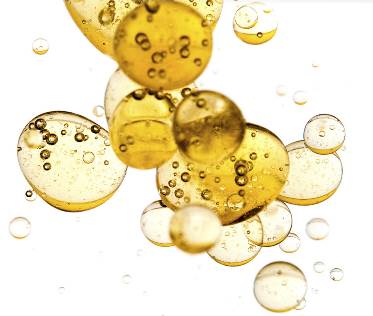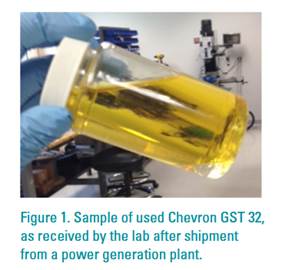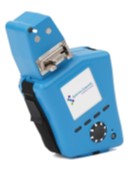油中水
Measuring Water in Oil
 We have all heard the saying, “Oil and water don’t mix.” Unfortunately that doesn’t necessarily apply to lubrication oils. Water can exist in several states in lubrication oils and can do quite a bit of damage to valuable assets if left unchecked. In this guide we explore the challenges posed by water in lubrication oils and discuss the methods available to reliability professionals for measuring water in oil.
We have all heard the saying, “Oil and water don’t mix.” Unfortunately that doesn’t necessarily apply to lubrication oils. Water can exist in several states in lubrication oils and can do quite a bit of damage to valuable assets if left unchecked. In this guide we explore the challenges posed by water in lubrication oils and discuss the methods available to reliability professionals for measuring water in oil.
Background
Water contamination in industrial oils can cause severe issues with machinery components. The presence of water can alter the viscosity of a lubricant as well as cause chemical changes resulting in additive depletion and the formation of acids, sludge, and varnish. Water testing is always a part of any lubricant condition monitoring program. Water contamination in industrial oils with strong water separation properties has been historically difficult to measure with any technique.
Water can coexist as three phases in an oil sample: dissolved, emulsion mix, and free globules which makes it challenging to obtain a representative sample. The additive formulations in these types of oils are designed to separate water efficiently above saturation limits of 50-250 ppm water. Above saturation, the water will form discrete water droplets and eventually separate from the oil if left to sit (Figure 1). Dissolved water is typically not too much of a concern for industrial applications but free water or emulsified water must be stringently controlled.
What techniques are available?
► INFRARED
A most promising technique for measuring water contamination is infrared spectroscopy. It is a widely used and accepted chemical-free measurement. In a very general sense, spectroscopy is the study between the interaction of radiated energy and matter. A spectrometer consists of a radiative source, a detector, and a computer or other converter of the detector signal to useful information. The sample to be studied is placed between the radiative source and the detector. In infrared absorption spectroscopy, the incident light beam is passed through a sample and the transmitted light is collected by the detector and typically reported as a spectrum of the transmitted or absorbed light as a function of the wavelength, , of the incident beam.
Pure water absorbs infrared light and can be detected by a peak in the infrared spectrum at around 3400 cm-1. When water is dissolved in another medium like oil, a water molecule still absorbs infrared light although the peak might be shifted slightly due to the different environment around that water molecule. ASTM standard practice E2412 measures water by correlating the peak in the infrared spectrum around 3350 cm-1 to the concentration of water (Figure 3). This method works great for certain types of applications, such as for motor oils which contain additives to help dissolve water. The analysis is fast, easy, and very reliable; results can be achieved by even a non-technical user.
When water exists as free or emulsified in oil, it can cause the light passing through the oil sample to scatter, thus affecting the measurement. In industrial lubricants, most of the water exists as an emulsion or as free water due to the demulsibility additives present in the oil. Water droplets suspended in oil can scatter light instead of absorb it.
Thus a water absorption peak around 3400 cm-1 cannot easily be correlated to the concentration of water above the saturation limit. One successful approach to counteract this scattering is the water stabilization method.1 This method pretreats the sample with an additive, such as a surfactant, which aids in the dissolution of the water in the oil so that the traditional water peak can be detected by infrared spectroscopy. The water stabilization method can work well with a skilled operator, but requires precise addition of chemicals into an oil sample prior to analysis- and this is not readily available in the field when needed. For this reason, the method has not been received well by condition monitoring labs using FTIR as a screening tool or by the end user in the field.
Another approach is the use of a homogenizer to mechanically incorporate the water as discrete water droplets suspended in the oil. Samples homogenized with a CAT 120X homogenizer and allowed to sit at room temperature for at least a minute demonstrated excellent correlation to Karl Fischer coulometric titration. The degree of elastic light scattering caused by a water-in-oil mixture indeed depends on the concentration of water present, but it also is strongly influenced by how the water is physically dispersed in the oil: the number and size of discrete water droplets present in the oil (Figure 4). The homogenizer acts to create a repeatable distribution of water droplets uniformly dispersed in the oil. Then, the degree of light scattering can be measured reliably by an infrared spectrometer.
The FluidScan oil analyzer is a rugged, handheld IR analyzer used to measure oil condition and chemistry. A series of oil samples with varying water concentrations were prepared using the homogenization technique and measured on the FluidScan. The results were compared to those obtained using Karl Fischer coulometric titration as showing in Figure 5. The FluidScan readings show excellent correlation to the titration method.
The new FluidScan method for analysis of water contamination in turbine oils is a robust, reliable method capable of providing immediate alert of severe water contamination. The largest contributor to the variation is the sampling. The homogenizer is a key component of the method. Hand-shaking is not sufficient for obtaining a homogeneous sample and reliable results for water measurement on the FluidScan. Immediate analysis at-site or the preparation of samples prior to analysis with a commercially available homogenizer is recommended for the best results. With best practice sampling techniques, results correlating within 20% to Karl Fischer can be achieved.
► CRACKLE TEST
The Crackle Test is a simple test to determine whether or not there is water in lubrication oil. The Crackle Test can be performed in the field using a hot plate. The Crackle Test is mostly qualitative. It tells you whether there is water present or not but doesn’t measure the amount of water present. Careful observation of the oil on the hot plate can give some semi-quantitative information about the amount of water present, but it is very dependent on the skill of the operator.
The Crackle Test requires a temperature controlled hot plate. Typically the hot plate temperature is set to approximately 320°F (160°C). Ideally the sample is mixed by vigorous shaking. This creates a more homogeneous suspension of water in oil. Once the sample is prepared, a drop of oil is placed onto the hot plate and observed.
If there is no water in the oil, no “crackling” will be observed. Conversely if the oil does contain liquid water, the heat will cause it to change to the vapor stage creating observable bubbles in the oil droplet. The size of the bubbles roughly corresponds to the amount of water present in the oil; the larger the bubbles, the more water there is dissolved in the oil. By observing the size of the bubbles created on the hot plate, some quantitative judgements can be made about the concentration of water present in the oil sample.
► CALCIUM HYDRIDE TEST KITS
Another way to determine water concentrations in the field is by using a calcium hydride test kit. In this test method, a known volume of oil is placed in a sealed container with a known amount of calcium hydride. The container is shaken vigorously causing the water in the oil to react with the calcium hydride, producing hydrogen gas. This chemical reaction is as follows:
CaH2 + 2 H2O → Ca(OH)2 + 2 H2
The calcium hydroxide [Ca(OH)2] product is a solid and precipitates out, while the H2 is hydrogen gas and its pressure is measured using a manometer. This reaction is stoichiometric, so one mole of water in solution will produce one mole of hydrogen gas. Therefore, measuring the pressure of the gas resulting from the reaction will tell you how much water was contained in the oil sample.
To run the test, an oil sample is taken using a syringe. Typically a test needs 20-30 ml of oil. This oil is dispensed into the reaction vessel, which typically has a screw cap to tightly seal the reaction vessel. If water levels are relatively high, the oil sample will need to be diluted using a known amount of diluent. The relative amount of oil and diluent will depend on the concentration of water in the oil sample. It is sometimes necessary to run the test more than once to determine the proper range of water contamination and to select the proper ratios of oil to diluent.
The calcium hydride is usually kept separate from the oil and diluent until the vessel is sealed so that all the hydrogen gas produced as a result of the chemical reaction is contained in the sample cylinder. Once the sample cylinder is sealed the oil and calcium hydride are combined and either shaken or agitated to begin the reaction. After a few minutes the manometer on the reaction vessel will read the pressure inside. This pressure reading is then translated into a % water reading depending upon the relative mix of oil and diluent. If there is too much water in the oil, the pressure in the vessel can be higher than the range read by the manometer. If this is the case, the pressure needs to be released, the apparatus cleaned and the ratio of oil to diluent reduced in order to fall into the measureable range.
Calcium hydride test kits usually come fully assembled with the pressure vessel, manometer, syringes, gloves, safety glasses, diluents, sealing rings, pre-measured packets of calcium hydride and sometimes a magnetic stirring plate. Used correctly, these test kits are reported to be accurate down to 50 ppm free or emulsified water. A helpful video showing how to run a test can be found here.
► KARL FISCHER
The most widely accepted method for detecting water in oil is by Karl Fischer (KF) coulometric titration (ASTM D6304). Karl Fischer analysis for water can yield highly accurate and repeatable results when executed by a skilled operator and is the comparative method for other analytical techniques for water determination. Also, the water can be measured in any state: dissolved, free, or emulsified.
Karl Fischer titration is used in a variety of industries and applications where water measurement is vital, such as in lubrication oils, pharmaceuticals and food. A titration is a technique where a solution of known concentration is used to determine the concentration of an unknown solution. Typically, the titrant (the know solution) is added from a burette to a known quantity of the analyte (the unknown solution) until the reaction is complete. In the case of Karl Fischer titration, the amount of iodine consumed is equivalent to the amount of water present in the sample. By measuring how much iodine is needed to titrate the oil sample, the water content of the oil can be determined very precisely.
Several companies, such as Sigma Aldrich, Mettler Toledo and Metrohm, make commercial Karl Fischer titrators for laboratories. Due to the sample preparation required and the use of volatile chemicals, Karl Fischer titration is almost always done in a laboratory and would be very difficult to use at the site of the equipment being tested. Read more here.
► RELATIVE HUMIDITY OR SATURATION METERS
Relative Humidity, or RH, sensors are used in a variety of industries where the humidity needs to be controlled, such as food services and pharmaceutical industries. RH sensors come in three types – capacitive, resistive and thermal conductivity. The sensors most commonly used to measure relative humidity in oil are usually capacitive, so we will restrict our discussion to this type.
Most people are familiar with relative humidity in air, particularly in warm climates during the summer season. The ability of air to hold water vapor is temperature dependent. The same is true with oil. Typically the warmer the oil, the greater is its ability to hold water. Of course, if the oil temperature is very high, like in an internal combustion engine, the high temperature will cause the water vapor to boil out of solution.
Humidity sensors can only measure dissolved water in oil. They can’t measure the amount of free or emulsified oil, so their application is limited. Nevertheless useful information can be obtained by monitoring the RH of oil.
A capacitive RH sensor usually consists of two conductive electrodes with a non-conductive layer between them. The non-conductive layer is typically a metal oxide or a polymer. The capacitance of this layer changes with water content and causes a change in voltage between the two conductive electrodes. The incremental change in the dielectric constant of a capacitive humidity sensor is proportional to the relative humidity of the surrounding environment. Capacitive sensors are characterized by low temperature coefficient, ability to function at high temperatures (up to 200°C), full recovery from condensation, and reasonable resistance to chemical vapors. Capacitive sensors typically have a good response time and can provide accurate readings within minutes.
The typical uncertainty of capacitive sensors is ±2% RH from 5% to 95% RH with two-point calibration. Capacitive sensors are limited by the distance the sensing element can be located from the signal conditioning circuitry, due to the capacitive effect of the connecting cable with respect to the relatively small capacitance changes of the sensor. A practical limit is <10 ft.2
Summary
There are several methods available to the reliability professional interested in measuring water in lubrication oil. The choice of methods is dependent on budget, training of personnel, precision of data required and other factors. The most important thing is to consistently monitor your equipment for water contamination to avoid unexpected downtime and equipment failure.
Get your free e-guide and find out more

